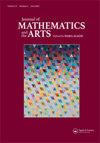Contemporary geometric beaded jewellery
IF 0.2
Q4 MATHEMATICS, INTERDISCIPLINARY APPLICATIONS
引用次数: 1
Abstract
I am a physician and bead artist living and working in beautiful Cape Town, South Africa. Mathematics and Science were my favourite subjects at school, and I knew early on that I wanted to study Medicine. In my spare time, I was always reading or making things. My mum taught us not only how to knit and sew, but also to value craftmanship. In 2004, I discovered off-loom beadweaving using a needle, thread and glass seed beads. Adding tiny glass beads one at a time is meditative and has been described as ‘painting in pixels’. When I am beading, I constantly ask ‘What if’ questions . . . Change the bead? Change the colour? Add something here or there? I love creating wearable geometric art. My work is inspired by the colours and patterns of nature, as well as by fine art and sculpture. As a core member of the Contemporary Geometric Beadwork (CGB) Research Team led by Kate McKinnon (USA), I have participated in discovery sessions with the team and undertook the technical illustrations for the books the team has published. Some of my designswere published inContemporaryGeometric BeadworkVolume II (2014) and in 2019 my beaded jewellery and fashion was shown at the mathematical arts conference Bridges, in Linz, Austria. Designing and beading geometric shapes involve mathematics, both in the planning stages and in the making. Writing patterns involve further calculations, especially when planning for a range of sizes. CGB designs are worked in peyote stitch, using precise Japanese cylinder beads, and much of the work is 3-dimensional. Some work is sewn in one piece, and some (like Kaleidocycles) require complex assembly. As one of the illustrators for the CGB Project, I study the already beaded shapes and 3-D structures and then draw step-by-step diagrams to allow beaders of different skill levels to bead our designs. In peyote stitch, the thread passes through each row of beads twice. One of the resultant characteristics which makes this stitch ideal for our work is the ability to remove a single thread to split our beadwork into separate sections with no loss of structural integrity. These ‘deconstructed’ sections can be crafted with known fit and dimension and used as templates for starting new work.当代几何串珠首饰
我是一名医生和头饰艺术家,生活和工作在美丽的南非开普敦。数学和科学是我在学校最喜欢的科目,我很早就知道我想学医学。在我的业余时间,我总是阅读或制作东西。我妈妈不仅教我们如何编织和缝纫,还教我们重视工艺。2004年,我发现了用针、线和玻璃种子珠编织的织机外珠编织。每次添加一个小玻璃珠是一种冥想,被描述为“像素绘画”。当我前进的时候,我经常问“如果”的问题……换头?换颜色?在这里或那里添加一些东西?我喜欢创作可穿戴的几何艺术。我的作品灵感来自大自然的色彩和图案,以及精美的艺术和雕塑。作为Kate McKinnon(美国)领导的当代几何珠饰(Contemporary Geometric珠饰,CGB)研究团队的核心成员,我与团队一起参加了发现会议,并为团队出版的书籍承担了技术插图。我的一些设计发表在《当代几何珠饰》第二卷(2014年)上,2019年,我的珠饰珠宝和时装在奥地利林茨的数学艺术会议Bridges上展出。设计和串珠几何形状涉及数学,无论是在规划阶段还是在制作阶段。编写模式涉及进一步的计算,特别是在规划大小范围时。CGB的设计采用佩奥特针,使用精确的日本圆柱珠,大部分作品都是三维的。有些作品是缝在一起的,有些(比如万花筒)需要复杂的组装。作为CGB项目的插画师之一,我研究已经存在的头部形状和3d结构,然后绘制一步一步的图表,让不同技能水平的头部引导我们的设计。在佩奥特针中,线穿过每排珠子两次。由此产生的特点之一,使这种针理想为我们的工作是能够去除单线分裂成我们的珠饰成单独的部分,而不损失结构的完整性。这些“解构”的部分可以用已知的适合度和尺寸来制作,并用作开始新工作的模板。
本文章由计算机程序翻译,如有差异,请以英文原文为准。
求助全文
约1分钟内获得全文
求助全文
来源期刊

Journal of Mathematics and the Arts
MATHEMATICS, INTERDISCIPLINARY APPLICATIONS-
CiteScore
0.50
自引率
0.00%
发文量
19
 求助内容:
求助内容: 应助结果提醒方式:
应助结果提醒方式:


